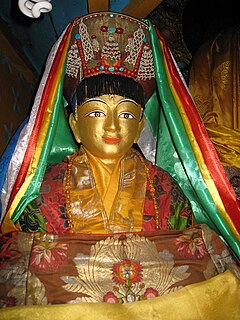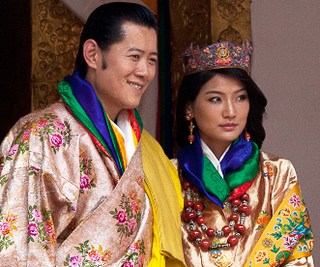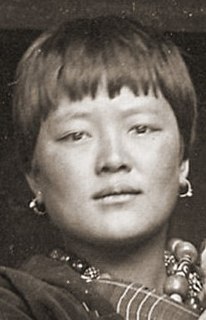Related Research Articles

Bhutan's early history is steeped in mythology and remains obscure. Some of the structures provide evidence that the region has been settled as early as 2000 BC. According to a legend it was ruled by a Cooch-Behar king, Sangaldip, around the 7th century BC, but not much is known prior to the introduction of Tibetan Buddhism in the 9th century, when turmoil in Tibet forced many monks to flee to Bhutan. In the 12th century, the Drukpa Kagyupa school was established and remains the dominant form of Buddhism in Bhutan today. The country's political history is intimately tied to its religious history and relations among the various monastic schools and monasteries.

Padmasambhava, also known as Guru Rinpoche, was an 8th-century Buddhist master from India. Padmasambhava was invited to Tibet by king Trisong Detsen and founded Tibetan Buddhism together with other invited scholars and masters. Padmasambhava is venerated as the "second Buddha" by the Nyingma school, the oldest buddhist school in Tibet known of as "the ancient ones". He helped construct the first Buddhist monastery in Tibet at Samye, at the behest of Trisong Detsen. Padmasambhava was presented with Yeshe Tsogyal, either the consort or wife of Trisong Detsen, and she became a great master and Buddha in her lifetime after studying with Padmasambhava.

Jetsun Milarepa was a Tibetan siddha, who famously was a murderer as a young man before turning to Buddhism and becoming a highly accomplished Buddhist disciple. He is generally considered one of Tibet's most famous yogis and spiritual poets, whose teachings are known among several schools of Tibetan Buddhism. He was a student of Marpa Lotsawa, and a major figure in the history of the Kagyu school of Tibetan Buddhism. He is also famous for the feat of climbing Mount Kailash.

Ngawang Namgyal and known colloquially as The Bearded Lama, was a Tibetan Buddhist lama and the unifier of Bhutan as a nation-state. In addition to unifying the various warring fiefdoms for the first time in the 1630s, he also sought to create a distinct Bhutanese cultural identity separate from the Tibetan culture from which it was derived.

Jigme Khesar Namgyel Wangchuck is the Druk Gyalpo or "Dragon King" of the Kingdom of Bhutan. After his father Jigme Singye Wangchuck abdicated the throne in his favour, he became the monarch on 9 December 2006. A public coronation ceremony was held on 6 November 2008, a year that marked 100 years of monarchy in Bhutan.

The House of Wangchuck has ruled Bhutan since it was reunified in 1907. Prior to reunification, the Wangchuck family had governed the district of Trongsa as descendants of Dungkar Choji. They eventually overpowered other regional lords and earned the favour of the British Empire. After consolidating power, the 12th Penlop of Trongsa Gongsar Ugyen Wangchuck was elected Druk Gyalpo, thus founding the royal house. The position of Druk Gyalpo is more commonly known in English as King of Bhutan.

Jetsun Pema is the sister of the 14th Dalai Lama. For 42 years she was the President of the Tibetan Children's Villages (TCV) school system for Tibetan refugee students.
Sonam is a given name. It is a Tibetan name meaning "merit". Separately, it is also a name in various Indo-Aryan languages.
Pema Dorji (1936-2009) a doctor (drungtsho) of traditional Bhutanese and Tibetan medicine, was the first person to institutionalize traditional medicine in Bhutan. He was the founding director of the National Indigenous Medicine Hospital and of the Institute of Indigenous Medicine in the capital Thimphu, and the key person behind the establishment of the Health Department's indigenous clinics and dispensaries in all 20 districts of Bhutan which make available free treatment and medicine to all the citizens of Bhutan.
Wangchuk or Wangchuck is a given name and surname. Notable people with the name include:
Dechen is a Tibetan name meaning "great bliss". It is a Tibetan translation of the Sanskrit term mahāsukha (महासुख). People with the name Dechen include:
Wangmo is a Tibetan name. People with this name include:
Prince GyaltshabJigme Dorji Wangchuck is the third eldest Prince of Bhutan. His brother Jigme Khesar Namgyel Wangchuck became the king following the abdication of his father on 14 December 2006.
The Kingdom of Bumthang was one of several small kingdoms within the territory of modern Bhutan before the first consolidation under Zhabdrung Ngawang Namgyal in 1616. After initial consolidation, the Bumthang Kingdom became Bumthang Province, one of the nine Provinces of Bhutan. The region was roughly analogous to modern day Bumthang District. It was again consolidated into the modern Kingdom of Bhutan in 1907.

The wedding of Jigme Khesar Namgyel Wangchuck, King of Bhutan, and Jetsun Pema took place on 13 October 2011 at the Punakha Dzong in Punakha, Bhutan. The current King of Bhutan, Jigme Khesar Namgyel Wangchuck, married Jetsun Pema, who became Queen Jetsun Pema Wangchuck. Both are descendants of the 48th Druk Desi of Bhutan and 10th Penlop of Trongsa, Jigme Namgyal.

Ashi Phuntsho Choden (1911–2003) was the Queen consort of Bhutan.
Dorji is a Tibetan and Bhutanese given name and surname.

Ashi Tsundue Pema Lhamo (1886–1922) was the first Queen consort of Bhutan.

Ashi Pema Dechen (1918–1991) was the Queen consort of Bhutan.

The Druk Gyaltsuen is the Queen consort of the Kingdom of Bhutan. In the Dzongkha language, Bhutan is known as Drukyul which translates as "The Land of the Thunder Dragon". Thus, while Queens of Bhutan are known as Druk Gyaltsuen, the Bhutanese people call themselves the Drukpa, meaning "Dragon people".
References
- ↑ Tucci, Giuseppe (1988). The Religions of Tibet. University of California Press. p. 319. ISBN 9780520063488.
- ↑ Gayley, Holly (2016). Love Letters from Golok: A Tantric Couple in Modern Tibet. Columbia University Press. p. 290. ISBN 9780231542753.
- ↑ Note that Tibetan names generally do not have surnames. See e.g. Childs, Geoff (2004). Tibetan Diary: From Birth to Death and Beyond in a Himalayan Valley of Nepal. University of California Press. p. 6. ISBN 9780520241336.
| This page or section lists people that share the same given name. If an internal link led you here, you may wish to change that link to point directly to the intended article. |